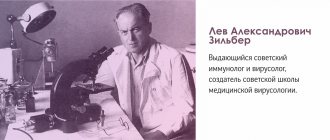Blood cancer, leukemia, leukemia or leukemia - these names define a type of malignant tumor that affects the bone marrow and is characterized by a high rate of metastasis. The disease is most often diagnosed in older people and children. A tumor occurs in the bone marrow as a result of the replacement of normal hematopoietic cells with malignant ones. This leads to disruption of the normal functioning of the hematopoietic system. The body stops producing platelets, leukocytes and red blood cells in the quantities necessary for life, producing white blood cells instead.
In the acute form of the disease, which occurs in children in 95% of cases, cells called blasts mutate. In the chronic form of leukemia, they degenerate into malignant mature blood cells. With the appearance of metastases, lymph nodes, kidneys, lungs, spleen, liver, etc. are affected.
Healthy organ tissue is gradually displaced, which leads to the following complications:
- the likelihood of developing infections increases;
- anemia appears;
- the risk of hemorrhage increases.
Classification
According to the nature of the flow, the following are distinguished:
- acute form of blood cancer with characteristic transience, headaches and convulsions, vomiting, bruising on the skin, weakness and decreased vitality;
- a chronic form with a slow course, weakness, bleeding gums, weight loss, increased body temperature, and frequent infectious diseases.
Chronic and acute forms of leukemia do not flow into one another.
According to the features of the clinical picture, the following are distinguished:
Lymphocytic leukemia, occurring in most cases in children 2-8 years old (boys - 80% of cases). The main reasons: genetic predisposition, infection of the mother during pregnancy. Symptoms of lymphocytic leukemia:
- enlarged lymph nodes, pale skin, breathing problems;
- sudden weight loss, fatigue, weakness;
- hardening or change in the size of the testicles;
- the appearance of ulcers when the skin is injured.
Acute myeloid leukemia most often develops after age 50. The cause is DNA defects in immature bone marrow cells. The symptoms of the disease are:
- dizzy, feeling weak and unwell;
- no appetite;
- pain appears in the joints and bones;
- Infectious diseases are becoming more frequent;
- increased bleeding is observed.
Acute monoblastic leukemia is diagnosed quite rarely. It can occur in a chronic or acute form. Main symptoms:
- enlarged lymph nodes;
- the appearance of scattered hemorrhages on the body;
- enlargement and hyperemia of the testicles in men;
- pale skin;
- abdominal pain and a feeling of heaviness in the liver area;
- stomatitis;
- arthralgia.
Multiple myeloma most often affects people over 43 years of age. The disease manifests itself as anemia, frequent bacterial infections, arthralgia, fractures, and bleeding.
Chronic myelocytic cancer in adults is diagnosed mainly in men 27-50 years old. The course is long-lasting and asymptomatic. Main symptoms:
- feeling of aching bones;
- weight loss, nausea and vomiting, discomfort and pain in the abdominal cavity;
- body temperature rises, shortness of breath is observed;
- Lymph nodes enlarge, dizziness and headaches are observed.
Lymphocytic cancer is practically asymptomatic. The main manifestations are:
- frequent infections;
- discomfort in the liver area;
- enlarged lymph nodes;
- sweating and weakness.
Monocyte chronic blood oncopathology is diagnosed more often in patients over 57 years of age. The course is practically asymptomatic.
Types of disease
The modern classification of leukemia includes several principles of division into types. First of all, it is worth mentioning the division of cases of the disease according to the nature of the course into:
- acute, characterized by rapid development and the formation of a large number of immature blood cells - blasts;
- chronic, which are characterized by a long course and pathological production of mature leukocytes with altered properties.
Another principle for classifying leukemia is based on the level of differentiation of the affected cells, which can be:
- undifferentiated;
- quotational;
- blast.
In addition, oncologists distinguish many types of leukemia according to the types of cells whose pathological changes underlie the disease. According to this principle, lymphoblastic, monoblastic, myeloblastic, lymphocytic, myeloma and other types of disease are distinguished.
Causes
The main reasons due to which this oncopathology may occur are:
- genetic predisposition;
- severe viral diseases that led to weakening of the body;
- ionizing radiation;
- medications, long-term use of antibiotics, chemicals (polymer materials, paints, varnishes, household chemicals);
- frequent stress.
But modern diagnostics show that oncology may have nothing to do with risk factors. There are cases when diagnostics revealed pathology in a person who had no apparent reason for the development of the disease.
Tumor markers
Tumor markers are specific proteins produced by malignant tumor cells. Normally, humans do not have such proteins or contain them in small quantities. Each organ has its own tumor marker; let’s look at the most frequently identified ones:
Tumor marker CA 12 , normal -
Okomarker CA 15-3 , normal
Tumor marker PSA , norm 0 - 4 ng/ml. Detects prostate cancer.
The tumor marker AFP (alpha-fetoprotein) is a marker of liver cancer. Also used in gynecology to determine fetal malformations. The norm for men and non-pregnant women is: 0.5 – 5.5 IU/ml.
Tumor marker Ca 19-9 , normal
Tests for tumor markers are carried out in the morning, on an empty stomach. Blood for analysis is taken from a vein.
Symptoms and signs of leukemia
A feature of blood cancer is the similarity of symptoms, especially in the early stages, with other diseases. Among them:
- fatigue, weakness, decreased vitality and immunity;
- the appearance of bruises on the body with minor mechanical impact;
- frequent rashes of unknown etiology, poor wound healing;
- enlargement of the liver, spleen and other organs;
- pain in bones and joints;
- memory impairment, insomnia or drowsiness;
- decreased hemoglobin level, anemia.
Provided timely treatment, the doctor can prescribe effective therapy and cure the disease.
The following signs indicate the transition of the disease to a severe stage:
- weight is significantly reduced;
- mucous membranes often bleed;
- the skin turns yellow or becomes very pale;
- wounds heal poorly or fester;
- There is bloating and pain in the hypochondrium.
The formation of dense subcutaneous nodes (lymphatic tissue tumors) in the areas of natural folds helps determine blood cancer in children.
How does acute myeloid leukemia develop?
Acute myeloid leukemia (AML) begins in the bone marrow, the soft inner part of the bones made up of fat and blood-forming cells, including stem cells, which become:
- lymphocytes, whose main task is to fight infections and tissue damage;
- or myeloid cells, which can turn into: white and red blood cells that carry oxygen from the lungs to other tissues, as well as platelets, which are necessary to stop bleeding - they help close holes in the vessels that occur with cuts or bruises.
Leukemia begins with a change in DNA, a molecule contained in every cell of our body in which all information about the body is encrypted. Such “breakdowns” occur due to exposure to chemicals, radiation, various diseases or random failures, and lead to the production of too many blasts - rapidly growing immature, that is, non-functioning white blood cells.
Normal blasts eventually turn into useful blood cells, but in leukemia they become tumorous, actively multiply and gradually replace normal ones, which leads to a number of serious consequences. In a healthy person there are not many of them - they make up 5% or less of the bone marrow, and are not found in the blood. In order for a doctor to diagnose “acute myeloid leukemia”, there must be at least 20%.
Such cells do not just circulate throughout the body - they spread to, accumulate and damage various organs, including lymph nodes, liver, spleen, testicles, brain and spinal cord.
Doctors distinguish two main forms of myeloid leukemia: - acute - developing suddenly and quickly; - and chronic - with this type of disease, blasts displace healthy blood cells much more slowly than with acute disease.
When to see a doctor
You should seek help from an oncohematologist if your health condition worsens if the following symptoms and signs are present:
- a sharp deterioration in health;
- unreasonable increase in body temperature;
- the appearance of rashes and bruises on the body;
- poor wound healing;
- pain in bones and joints;
- symptoms of anemia;
- hemoglobin levels and immunity are reduced.
Signs of deteriorating health in any case are a reason to contact the oncology center so that the doctor can prescribe additional tests and adjust the treatment.
Stool analysis
Blood may also be present in the stool, and it is almost impossible to notice it visually. Laboratory analysis will help determine its presence.
The presence of blood in the stool is a sign of intestinal cancer (most often colon), but it is also a symptom of many benign gastrointestinal diseases. Polyps in the intestines can bleed. Moreover, it should be remembered that polyps tend to degenerate into a malignant tumor. In any case, the presence of blood in the stool is a reason to undergo a more in-depth diagnosis and take tests to detect cancer.
Feces are also collected in a sterile container in the morning.
Diagnosis of leukemia in the oncology center
Diagnosis of leukemia in the oncology center, located at 2nd Tverskoy-Yamskaya Lane, is carried out in several stages:
- initial examination by a doctor with medical history;
- general and biochemical blood test;
- taking tests using modern diagnostic techniques: MRI, ultrasound, PET/CT, radiography, scintigraphy, SPECT.
One of the most informative diagnostic methods is bone marrow puncture (immunohistochemistry of punctate, cytochemical and cytogenetic analyses).
Highly qualified oncology specialists use the latest diagnostic equipment, which guarantees high diagnostic accuracy and safety for patients.
Acute myeloid leukemia status after treatment
The long-term prognosis of each patient largely depends on how well and quickly the disease responds to treatment: the better the body’s first reaction, the more optimistic the prospects.
Remission - no signs of leukemia: the bone marrow contains less than 5% blasts. Blasts are rapidly growing immature, non-functioning white blood cells. , and the number of blood cells is within normal limits. Complete molecular remission means that doctors were unable to detect the altered cells even with very sensitive tests.
Minimal residual disease , MRD: This term is used when, after treatment, abnormal cells are not detected by conventional methods - for example, by standard examination of samples under a microscope, but are detected by modern accurate examinations.
Active disease: after treatment there are more than 5% blasts in the bone marrow, or after therapy a relapse occurred - the disease returned.
Treatment of blood cancer at the oncology center
When developing tactics in the treatment of blood cancer, the type of pathology and individual characteristics of the patient are taken into account. Oncology doctors provide effective treatment using the following methods:
- chemotherapy, which is the process of introducing chemical drugs into the body that have a destructive effect on the tumor, using innovative syringe and infusion pumps;
- targeted drug therapy, during which only tumor cells are destroyed;
- radiation therapy (radiotherapy).
Treating oncology under compulsory medical insurance – what is needed for this?
You can receive FREE medical care at the Oncology Center under the State Guarantee Program of Compulsory Medical Insurance (Compulsory Medical Insurance) and High-Tech Medical Care.
The service is valid for all Russian citizens.
To find out more details, as well as for what nosologies and services this program works, please call +7, or you can read in more detail here.
Treatment and diagnosis of oncology are expensive medical services. The examinations alone cost a lot of money, and this is only the beginning of an already difficult path. Therefore, many patients are forced to postpone cancer treatment, since financial losses can literally ruin them. In this regard, the Sofia Clinic offers a number of services under the health insurance policy. Free cancer treatment under compulsory medical insurance is available to all Russian citizens. First of all, patients with very serious diagnoses, for whom treatment is a matter of life and death, can count on it. Such cancer patients are provided with quotas, which are financed from the federal and local budgets. As part of treatment under compulsory medical insurance, the following procedures are performed:
- PET/CT;
- radiation therapy;
- chemotherapy;
- IHC;
- surgery.
The decision to provide free oncology treatment under compulsory medical insurance is made by three commissions - the clinic, the health department and the medical institution itself. You can shorten this path if you immediately contact us and ask what procedures our clinic issues quotas for. The doctor (therapist or oncologist) will prepare a statement with the diagnosis and information about what diagnostics you have already undergone. You will need to submit to the regional health authority:
- medical direction;
- application for treatment of cancer under the compulsory medical insurance policy;
- Russian passport and insurance policy;
- SNILS;
- consent to the processing of personal data;
- pension certificate (for pensioners).
Benefits of onco
The success of oncology treatment greatly depends on the level of the clinic. And it’s not just about the professionalism of doctors and specialists conducting diagnostics. All therapeutic procedures must be performed using modern and high-tech medical equipment. The same applies to devices on which diagnostics are carried out. The data obtained with their help must be as accurate as possible so that the doctor can determine the location of the lesion and the stage of oncological pathology. And don’t forget about patient comfort. Diagnosis and treatment of oncological diseases takes a lot of time. Patients often have to spend the whole day within the walls of a medical facility, and some patients are undergoing inpatient treatment. Therefore, it is important that the environment and atmosphere be as favorable as possible. Onko took into account both his own 30 years of experience and the experience of foreign medical institutions. This allows us to diagnose cancer tumors and treat cancer patients with maximum efficiency, safety and comfort. See for yourself:
- Each of our doctors is a highly qualified specialist with many years of experience both in Russia and in hospitals in the USA, Europe and Israel. We employ leaders of domestic medicine, as well as competent international consultants.
- Diagnostics and therapeutic procedures are carried out in beautiful and cozy rooms. We have decorated our departments in a stylish design so that the interior looks as little as possible like a hospital room. Also for patients and their accompanying people there is a café and a restaurant on the roof with panoramic views of the city.
- High safety and quality levels have been repeatedly confirmed by numerous certificates and awards. We carry out our activities in strict accordance with domestic and international standards, which allows us to minimize side effects and significantly increase the chances of recovery.
Make an appointment
Our oncology clinic is located in the very center of Moscow, close to several metro stations - Novoslobodskaya, Tverskaya, Chekhovskaya, Belorusskaya and Mayakovskaya. For visitors arriving by car, there is ample parking available on the medical grounds. Our employee will help you find your way around the clinic, take you to the right department and tell you where this or that office is located.
You can make an appointment with a specialist:
- by calling a phone number;
- online by filling out a special form on the website;
- ordering a call back.









